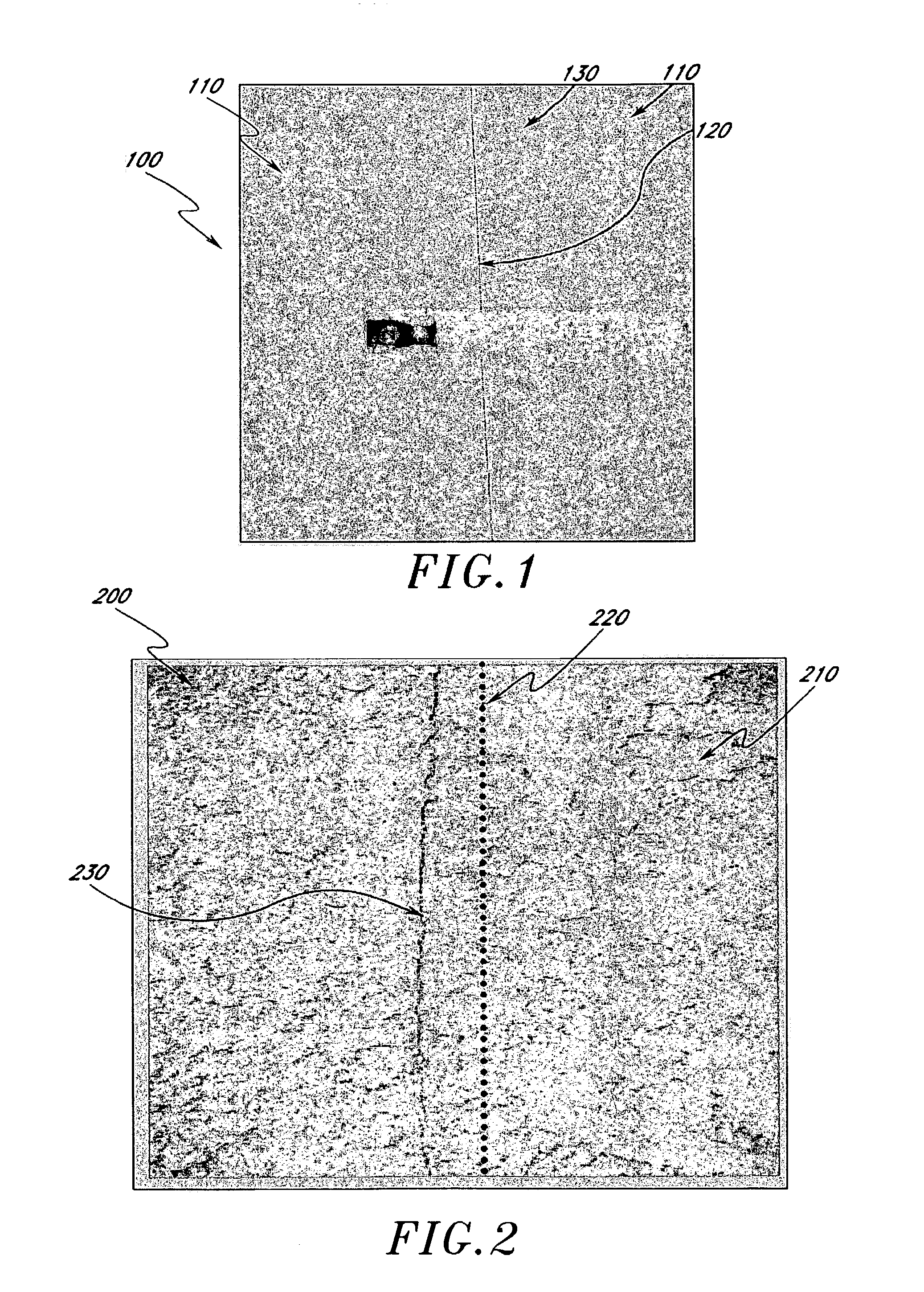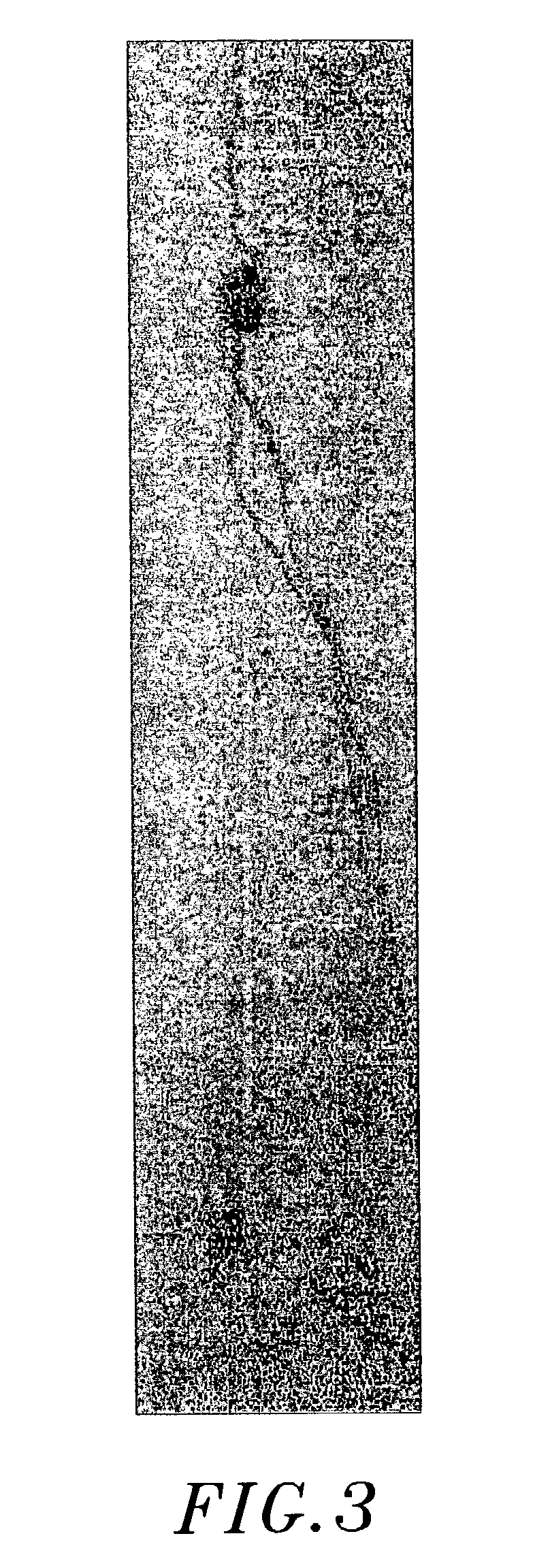Trough-edge building panel and method of manufacture
a technology of building panels and troughs, applied in the field of troughs, can solve the problems of affecting the appearance of the building, the susceptibility of the stucco, and the use of stucco as an exterior finish
- Summary
- Abstract
- Description
- Claims
- Application Information
AI Technical Summary
Benefits of technology
Problems solved by technology
Method used
Image
Examples
example 1
Comparative Testing of Joint Flexibility for Trough-Edge Panels
[0105]Tensile testing of the flexibilities of joints constructed from panels with different embossed trough depths was performed on a universal testing machine at a strain rate of about 5 to 10 mm per minute. Three different joint configurations were tested on a substrate of 5 / 16″-thick fiber-cement panel (Hardipanel, James Hardie, Fontana, Calif.). Each joint was caulked, taped with 3″-wide tape, and finished with a synthetic stucco finish. The joints were caulked with a 100% urethane caulk (Chem-calk, Bostik Findley), taped with a 3″-wide elastomeric tape (Multicoat Elastomeric Joint Tape, Multicoat, Costa Mesa, Calif.) centered over the joint, and finished with a medium grit worm finish synthetic stucco (MultiTex, Multicoat, Costa Mesa, Calif.). In the panels with troughs, the troughs were spaced such that the edges of the tape fell within the troughs.
[0106]The testing results reported in TABLE 2 demonstrate the impro...
example 2
Joint Without an Adhesive Layer
[0117]Two 2″×5″ primed fiber cement specimens (James Hardie, Fontana, Calif.) were arranged with a ⅛″ gap between them. The gap was filled with 100% polyurethane caulk (Chem-calk 900, Bostik Findley), the caulk surface smoothed, and the caulk allowed to cure overnight. A 2″×3″ piece of backing material (Sontara 8801 fabric, Dupont) was centered and applied over the joint, and the surface finished with a medium texture ( 1 / 16″) elastomeric latex stucco (Multicoat, Costa Mesa, Calif.). The thickness of the texture coating was from about 0″ to about 1 / 16″, varying with the texture pattern on the surface. No additional adhesive layer was applied between the cementitious board and the fabric. Instead, the texture coating penetrated the backing material reaching the fiber cement panel beneath, and adhering the backing material to the panels.
[0118]The sample was equilibrated at 72° F. at 50% relative humidity for 7 days before tensile testing. The texture coa...
example 3
Joint Without a Backing Material
[0120]Two 2″×5″ primed fiber cement specimens (James Hardie, Fontana, Calif.) were arranged with a ⅛″ gap between them. The gap was caulked and cured as described in EXAMPLE 2. A 2″×3″ layer of 0.028″ thick PVT-3300 adhesive (Carlisle Coating & Waterproofing Inc.) was centered and applied over the joint. The test sample was finished and the finish cured as in EXAMPLE 2. Tensile testing indicated that the texture coating cracked when the joint was stretched about 1–2.5 mm (1.3%–3.3%) at 6 mm / min at 72° F. Thus, this type of joint would not withstand the normal expected movement of 4′×8′ fiber cement panels. Furthermore, because the adhesive layer did not absorb the latex-based texture coating, the joint was clearly visible after the coating cured.
PUM
| Property | Measurement | Unit |
|---|---|---|
| elongation | aaaaa | aaaaa |
| elongations | aaaaa | aaaaa |
| elongations | aaaaa | aaaaa |
Abstract
Description
Claims
Application Information
 Login to View More
Login to View More - R&D
- Intellectual Property
- Life Sciences
- Materials
- Tech Scout
- Unparalleled Data Quality
- Higher Quality Content
- 60% Fewer Hallucinations
Browse by: Latest US Patents, China's latest patents, Technical Efficacy Thesaurus, Application Domain, Technology Topic, Popular Technical Reports.
© 2025 PatSnap. All rights reserved.Legal|Privacy policy|Modern Slavery Act Transparency Statement|Sitemap|About US| Contact US: help@patsnap.com



